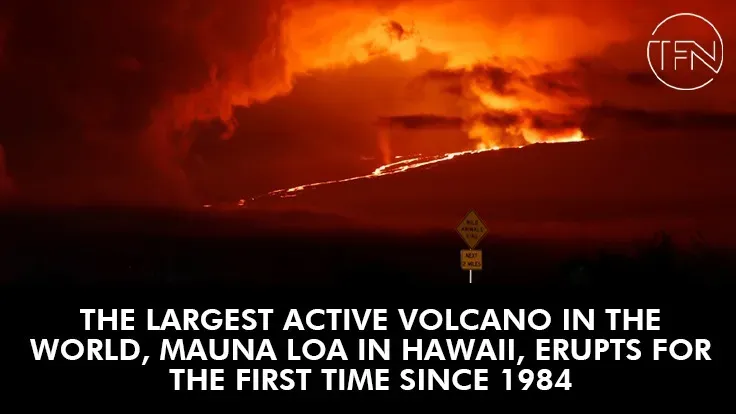The U.S. Geological Survey reports that Hawaii's Mauna Loa, the largest active volcano on Earth, is erupting for the first time since 1984.
According to the USGS's volcanic activity service, the volcano has been spewing ash and lava up to 200 feet in the air since around 11:30 p.m. local time on Sunday.
On the Big Island, people had been dreading this day for years. After the longest period of silence in recorded history, Mauna Loa was overdue for an eruption. Authorities had to block off a portion of the volcano's peak last month because it had experienced minor earthquakes, which indicated that an eruption might occur at any time.
In Hawaii, because the islands are made up of volcanoes, eruptions are a given.
Volcanologists haven't made any predictions about the duration or potential path of Mauna Loa's eruption. According to the USGS, the lava in the early phases of the volcano's previous eruptions changed direction quickly.
The USGS reported on Monday that the lava is now emerging through fissures northeast of the peak after the first erupting from the summit. Although the USGS stated that no adjacent villages were in danger from the lava flows, the people should be ready for this to change. As a precaution, the authorities opened shelters on the island.
A flatter area where the lava will have time to cool and spread more slowly, according to state officials, is where the eruption has shifted. Compared to hours on steeper slopes, it might take weeks or months for lava to potentially reach the sea.
As of Monday afternoon, there have been no reports of injuries, fatalities, or damage brought on by the most recent eruption. Authorities claimed on Monday that while no evacuations had been ordered, some residents had departed voluntarily. Public schools stayed open.
Governor of Hawaii David Ige advised people traveling to the state not to reschedule their travel plans because lava flows weren't endangering populated areas below the volcano.
The Mauna Loa and Kilauea eruptions are expected to draw more people, the National Park Service predicted on Monday. Since September 2021, Kilauea, another volcano on the Big Island, has been erupting at its summit.
The most recent eruption of Mauna Loa in 1984 lasted for around three weeks. Although the eruption did not cause any deaths, others have. In recent years, several volcanoes in Hawaii have erupted.
Being more than 13,600 feet above sea level, Mauna Loa dominates the Big Island. On Monday morning, many reported seeing the sky cast in bright orange kilometers away from the peak of Mauna Loa on social media.
On Monday morning, 33-year-old Paul Francis received texts from friends on the American mainland asking if he could see the eruption. He looked up as he left his motel in Waikoloa Village, which is roughly 40 miles northwest of the peak of Mauna Loa.
The sky appeared to be on fire, according to Mr. Francis, who was visiting from Kansas City, Missouri, to honor his mother's retirement.
He claimed that as the lava streamed down the volcano, a longer streak of it could be seen. Smoke was also seen beneath the clouds.
Mr. Francis, a training specialist with a pharmacy software business, added, "Once in a lifetime for sure."
Volcanologists had predicted that Mauna Loa would re-erupt and endanger the people of the Big Island. According to geologists, Mauna Loa has erupted on average every six years during the previous 3,000 years. The remainder of recorded eruptions sent lava streaming down toward settlements, while the other half remained in the summit region.
In September, the USGS said that it had noted more than thirty earthquakes beneath Mauna Loa but that this did not necessarily mean magma was migrating upward.
The agency reported dozens of earthquakes with a magnitude of up to 4.2 that occurred yesterday close to Mauna Loa.
On Monday, the Honolulu office of the National Weather Service issued an ashfall advisory for the island. Monday's air quality, according to state health experts, remained normal, but people should be ready for volcanic gases or ash to circulate.
Transportation authorities advised visitors planning to go to the Big Island to check with their airlines before departing due to the eruption.
According to Southwest Airlines Co., the eruption may force some flights to Hawaii to be delayed or canceled.
According to a scientist, it seems improbable that lava will spontaneously erupt from Hawaii's Mauna Loa volcano's peak. Lava in the crater could overflow, much like a bathtub would if there was too much of it. She continues by saying that it is challenging to foresee how long this eruption will occur or where the lava will travel.
Levees were destroyed by lava from the Mauna Loa eruption in 1984, which came very close to Hilo. It came to a standstill around 4.5 miles outside of Hilo, in part because the lava's approach was impeded by thick vegetation. Officials stated on Monday that the lava flow appeared to be nearly a mile long. Despite not being fatal, the 1984 eruption incinerated everything in its path.

